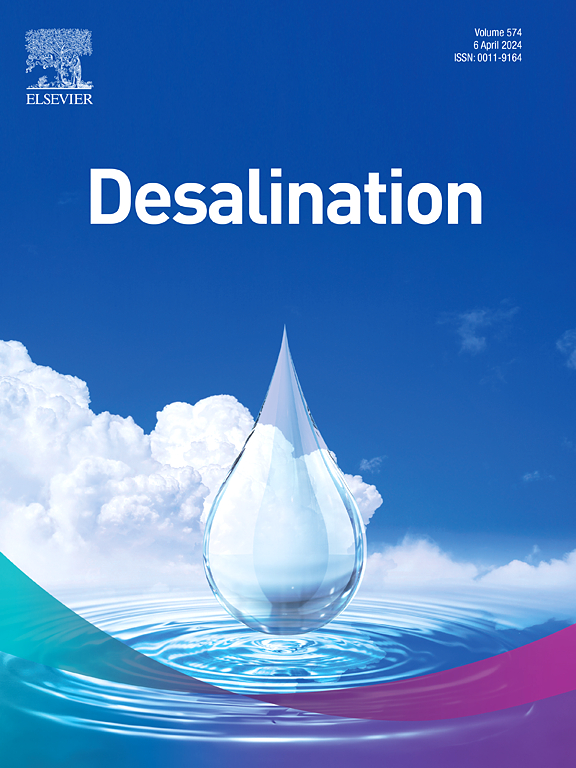Pine needle extract as inhibitor in heat exchanger pickling process to improve the performance of multi-stage flash desalination
IF 9.8
1区 工程技术
Q1 ENGINEERING, CHEMICAL
引用次数: 0
Abstract
Pine needle extract (PNE) was obtained through decoction method, utilizing distilled water as the solvent. This method not only ensures the efficient extraction of active ingredients from pine needles, but also achieves process optimization that is green, environmentally friendly, low-cost, and free of organic solvent residues. The PNE showed excellent performance for Cu90Ni10 in H2SO4 environment. The results from the electrochemical experiments reveal that a concentration of 600 mg/L of pine needle extract exhibits corrosion inhibition performance exceeding 97 %. Between 298 K and 318 K, the pine needle extract consistently demonstrates anti-corrosion efficiency exceeding 95 %. The polarization curve indicates that the PNE has the ability to suppress both cathodic oxygen reduction and anodic metal dissolution processes in Cu90Ni10. The scanning electron microscopy (SEM) observations indicate that the addition of PNE significantly reduces surface pitting and oxidation on the Cu90Ni10 alloy immersed in H2SO4 medium. XPS analysis reveals that the ingredients in PNE can form Cu![]() N bonds and can form effective chemical adsorption to form molecular films. Theoretical calculations demonstrate that bio-active constituents within PNE possess exceptional corrosion-inhibiting capabilities. Adsorption modeling confirms that the interaction between PNE and copper-nickel alloy involves a combination of physical adsorption and chemical bonding mechanisms.
N bonds and can form effective chemical adsorption to form molecular films. Theoretical calculations demonstrate that bio-active constituents within PNE possess exceptional corrosion-inhibiting capabilities. Adsorption modeling confirms that the interaction between PNE and copper-nickel alloy involves a combination of physical adsorption and chemical bonding mechanisms.

松针提取物在换热器酸洗过程中作为抑制剂改善多级闪蒸脱盐性能
以蒸馏水为溶剂,采用煎法制得松针提取物。该方法不仅保证了松针有效成分的高效提取,而且实现了绿色环保、低成本、无有机溶剂残留的工艺优化。PNE在H2SO4环境下对Cu90Ni10表现出优异的性能。电化学实验结果表明,当松针提取物浓度为600 mg/L时,其缓蚀性能超过97%。在298 ~ 318 K范围内,松针提取物的防腐效率始终保持在95%以上。极化曲线表明PNE具有抑制Cu90Ni10中阴极氧还原和阳极金属溶解的能力。扫描电镜(SEM)观察表明,PNE的加入显著降低了H2SO4介质中Cu90Ni10合金的表面点蚀和氧化。XPS分析表明PNE中的成分能形成CuN键,并能形成有效的化学吸附形成分子膜。理论计算表明,PNE中的生物活性成分具有优异的缓蚀能力。吸附模型证实PNE与铜镍合金的相互作用涉及物理吸附和化学键结合机制。
本文章由计算机程序翻译,如有差异,请以英文原文为准。
求助全文
约1分钟内获得全文
求助全文
来源期刊

Desalination
工程技术-工程:化工
CiteScore
14.60
自引率
20.20%
发文量
619
审稿时长
41 days
期刊介绍:
Desalination is a scholarly journal that focuses on the field of desalination materials, processes, and associated technologies. It encompasses a wide range of disciplines and aims to publish exceptional papers in this area.
The journal invites submissions that explicitly revolve around water desalting and its applications to various sources such as seawater, groundwater, and wastewater. It particularly encourages research on diverse desalination methods including thermal, membrane, sorption, and hybrid processes.
By providing a platform for innovative studies, Desalination aims to advance the understanding and development of desalination technologies, promoting sustainable solutions for water scarcity challenges.
 求助内容:
求助内容: 应助结果提醒方式:
应助结果提醒方式:


